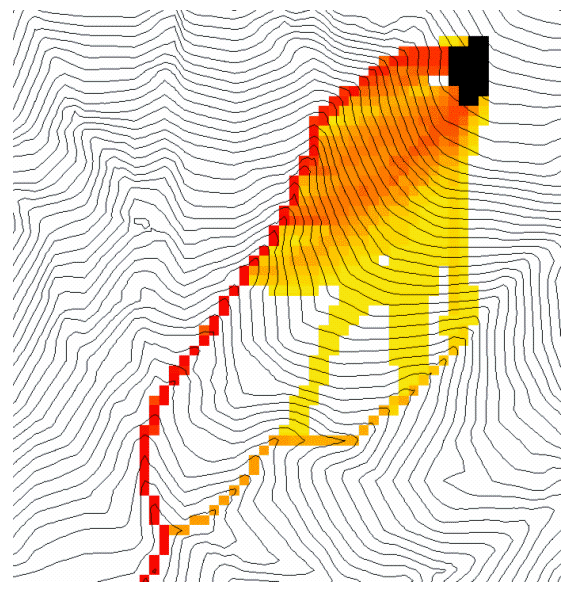D-Infinity Decaying Accumulation¶
Description¶
The D-Infinity Decaying Accumulation tool creates a grid of the accumulated quantity at each location in the domain where the quantity accumulates with the D-infinity flow field, but is subject to first order decay in moving from cell to cell. By default, the quantity contribution of each grid cell is the cell length to give a per unit width accumulation, but can optionally be expressed with a weight grid. The decay multiplier grid gives the fractional (first order) reduction in quantity in accumulating from grid cell x to the next downslope cell.
A decayed accumulation operator DA[.] takes as input a mass loading field m(x) expressed at each grid location as m(i, j) that is assumed to move with the flow field but is subject to first order decay in moving from cell to cell. The output is the accumulated mass at each location DA(x). The accumulation of m at each grid cell can be numerically evaluated.

Here d(x) = d(i ,j) is a decay multiplier giving the fractional (first order) reduction in mass in moving from grid cell x to the next downslope cell. If travel (or residence) times t(x) associated with flow between cells are available d(x) may be evaluated as exp(-k t(x)) where k is a first order decay parameter. The weight grid is used to represent the mass loading m(x). If not specified this is taken as 1. If the outlets shapefile is used the function is only evaluated on that part of the domain that contributes flow to the locations given by the shapefile.

Useful for a tracking contaminant or compound subject to decay or attenuation.
Parameters¶
- D-Infinity Flow Direction Grid [raster]
- A grid giving flow direction by the D-infinity method. Flow direction is measured in radians, counter clockwise from east. This grid can be created by the function “D-Infinity Flow Directions”.
- Decay Multiplier Grid [raster]
- A grid giving the factor by which flow leaving each grid cell is multiplied before accumulation on downslope grid cells. This may be used to simulate the movement of an attenuating substance.
- Weight Grid [raster]
Optional.
A grid giving weights (loadings) to be used in the accumulation. If this optional grid is not specified, weights are taken as the linear grid cell size to give a per unit width accumulation.
- Outlets Shapefile [vector: point]
Optional.
This optional input is a point shapefile defining outlets of interest. If this file is used, the tool will only evaluate ther area upslope of these outlets.
- Check for edge contamination [boolean]
This option determines whether the tool should check for edge contamination. Edge contamination is defined as the possibility that a value may be underestimated due to grid cells outside of the domain not being considered when determining contributing area.
Default: True
Outputs¶
- Decayed Specific Catchment Area Grid [raster]
- The D-Infinity Decaying Accumulation tool creates a grid of the accumulated mass at each location in the domain where mass moves with the D-infinity flow field, but is subject to first order decay in moving from cell to cell.
Console usage¶
processing.runalg('taudem:dinfinitydecayingaccumulation', -ang, -dm, -wg, -o, -nc, -dsca)